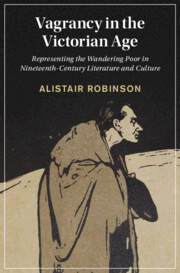‘… the first notable scholarly work to concentrate exclusively upon nineteenth-century representations of vagrancy - and as such is a highly welcome addition to the wider domain of vagrancy studies, which has so far generally failed to cover this area in detail … as well as offering a wide-ranging and clear account of some of the defining transitions in nineteenth-century attitudes towards vagrancy, alongside a nuanced analysis of how different authors responded to the figure of the vagrant, Vagrancy in the Victorian Age convincingly captures a sense of how attitudes towards vagrancy converged around adjacent prejudicial and subjugatory discourses, while simultaneously providing an opportunity for radical counter-trends to flourish.’
Luke Lewin Davies
Source: Journal of Victorian Culture Online
‘… combines small details and considerable analysis to build a taxonomy that is structurally holistic and, often, really quite moving.’
Delphine Gatehouse
Source: BAVS Newsletter
‘a first-rate account of the causes of poverty in the nineteenth century, the reasons for the rapid growth of London street life during this time, the blundering attempts to alleviate the misfortunes of the ‘worthy’ poor and the misguided urge to punish and reject those who were deemed unworthy.'
Ana Alicia Garza
Source: Times Literary Supplement
‘… excellent … Robinson's book has set a very high benchmark for those that will undoubtedly follow in its wake.’
Luke Seaber
Source: Victorian Periodicals Review
‘The meticulous research and nuanced discussion of vagrancy offered in Robinson’s book thus adds to our understanding of Dickens’s representations, while stimulating us to consider their significance further.’
Tamara S. Wagner
Source: Dickens Quarterly
‘… elegantly written and fascinating … this book significantly adds to our understanding not only of nineteenth-century representations of poor people on the move but also of the mobilizations of those representations themselves.’
Carolyn Betensky
Source: Modern Language Quarterly
‘… excellent … Robinson's book has set a very high benchmark for those that will undoubtedly follow in its wake.’
Luke Seaber
Source: Victorian Periodicals Review
'… a well-written and thought-provoking work, and one that in showing the protean and portable nature of the represented vagrant widens the subject in interesting ways …'
Stephen Ridgwell
Source: Journal of Victorian Culture
‘… a first-rate account of the causes of poverty in the nineteenth century, the reasons for the rapid growth of London street life during this time, the blundering attempts to alleviate the misfortunes of the 'worthy' poor and the misguided urge to punish and reject those who were deemed unworthy … groundbreaking …’
Ana Alicia Garza
Source: The Times Literary Supplement
‘… a detailed, critical, and historically informed engagement with the range of vagrancy in Victorian Britain and its empire - and the way in which these forms of vagrancy were understood, depicted, and also pressed into categories. … The meticulous research and nuanced discussion of vagrancy offered in Robinson’s book thus adds to our understanding of Dickens’s representations, while stimulating us to consider their significance further.’
Tamara S. Wagner
Source: Dickens Quarterly



